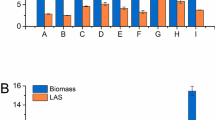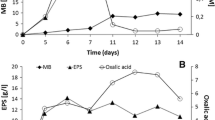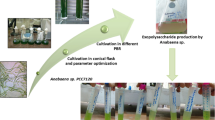Summary
Exopolysaccharide production by the fungus Acremonium persicinum was affected by the culture system used. The yields achieved in shake flasks were not obtained in a stirred tank reactor, except at very low stirring speeds (100 rpm). However when grown in an air-lift fermentor, exopolysaccharide levels were similar to those found with shake flask cultures. Results suggest that both dissolved oxygen tension and shear rate may determine the ability of this organism to synthesise this exopolysaccharide.
Similar content being viewed by others
References
Dosoretz CG, Chen AHC, Grethlein HE (1990) Effects of oxygenation conditions on submerged cultures of Phanerochaete chrysosporium. Appl Microbiol Biotechnol 34:131–137
LeDuy A, Choplin L, Zajic JE, Luong JHT (1988) Pullulan. In: Kroschwitz JI, Brooks P, Klingsheug A, Baldwin T (eds) Encyclopaedia of Polymer Science and Engineering, vol 3. Wiley, New York, pp 650–660
Michel N, Seviour RJ, Pethica LM (1987) Exocellular polysaccharide production by isolates of Epicoccum purpurascens. Biotechnol Lett 9:741–744
Phillips KR, Lawford HG (1983) Curdlan: its properties and production in batch and continuous fermentation. In: Bushell M (ed) Progress in industrial microbiology, vol 18. Elsevier, Amsterdam, pp 201–230
Rau U, Miller RJ, Cordes K, Klein J (1990) Process and molecular data of branched 1,3-β-d-glucans in comparison with xanthan. Bioprocess Eng 5:89–93
Sandford PA (1979) Extracellular microbial polysaccharides. Adv Carbohydr Chem Biochem 36:265–313
Stasinopoulos SJ, Seviour RJ (1989) Exopolysaccharide formation by isolates of Cephalosporium and Acremonium. Mycol Res 92:55–60
Stasinopoulos SJ, Seviour RJ (1990) Stimulation of exopolysaccharide production in the fungus Acremonium persinicum with fatty acids. Biotechnol Bioeng 36:778–782
Stasinopoulos SJ, Seviour RJ, Auer DF (1989) Inhibition of fungal exopolysaccharide production by chemical antifoams. Lett Appl Microbiol 8:91–93
Sutherland IW, Ellwood DC (1979) Microbial exopolysaccharides — industrial polymers of current and future potential. In: Bull AT, Ellwood DC, Ratledge C (eds) Microbial technology —current and future prospects. Cambridge University Press, Cambridge, pp 107–150
Wecker A, Onken U (1991) Influence of dissolved oxygen concentration and shear rate on the production of pullulan by Aureobasidium pullulans. Biotechnol Lett 13:155–160
Yoshioka Y, Tabeta R, Saito H, Yehara N, Fukuoka F (1985) Antitumour polysaccharides from Pleurotus ostreatus Quel: isolation and structure of a β-glucan. Carbohydr Res 140:93–100
Author information
Authors and Affiliations
Additional information
Offprint requests to: R. J. Seviour
Rights and permissions
About this article
Cite this article
Stasinopoulos, S.J., Seviour, R.J. Exopolysaccharide production by Acremonium persicinum in stirred-tank and air-lift fermentors. Appl Microbiol Biotechnol 36, 465–468 (1992). https://doi.org/10.1007/BF00170184
Received:
Accepted:
Issue Date:
DOI: https://doi.org/10.1007/BF00170184




